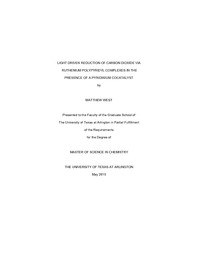| dc.description.abstract | The rapid increase in atmospheric carbon dioxide since the industrial revolution is now beginning to cause global climate changes which could adversely affect our planets ecosystem. Nonetheless, our ability to sustain the current world population and standard of living relies on cheap and abundant energy which is only currently obtainable from the continued use of fossil fuels, which further add CO2 to the atmosphere. Given these circumstances, there is considerable interest and urgency in the development of new technology which would help us replace fossil fuels with fuels derived from sustainable energy sources, and in particular, the sun. In particular, a process for the solar-driven reduction of CO2 into useful liquid transportation fuels, such as methanol, could lead to a carbon-neutral fuel cycle and eliminate the need for fossil fuels. If photochemical processes are to be developed along these lines, the incident solar radiation, which is predominantly in the visible portion of the electromagnetic spectrum, must be effectively absorbed by photocatalysts which then go on to drive the desired reactions. Ru(II) and Re(II) transition metal complexes are among the most widely studied chromophores for solar fuel photochemical processes. In particular, [Ru(phen)3]2+ Ru(bpy)3]2+, [Ru(tpy)2]2+, and more recently [Ru(bqp)2]2+ (where bpy = 2,2’-bipyridine, tpy = 2,2’:6’,2’’-terpyridine, and bqp = 2,6-di(quinolin-8-yl)pyridyl) have enjoyed considerable attention due to their good chemical stability and promising photophysical properties, including good absorption in the visible and long lived 3MLCT states. In this thesis, these complexes were studied computationally to determine what factors affect their excited state lifetimes, which are seen to vary from 0.25 ns to 3 s. Previous researchers have proposed an electronic model in which thermal population of triplet metal centered states from the 3MLCT state is the key factor in determining excited state lifetime. The closer in energy that the two excited states are, the faster is the non-radiative decay. In this study, we examine the structural features including ligand structure, denticity, metal-ligand bond angles, and deviations from octahedral geometry and correlate these factors to the excited state lifetime, in view of the existing electronic model. The calculations show that the HOMO is metal centered (t2g in Oh) whereas the LUMO is ligand centered (*) The LUMO+1 has mixed ligand * and metal eg character, the extent of which depends strongly on the degree of distortion from Oh symmetry, as measured by the bond angles about the metal center. The greater the degree of distortion, the greater the eg character of the LUMO+1 and also the closer in energy it is to the LUMO. Thermal population of energetically similar excited states [(t2g5 – *1 (LUMO)] and [t2g5 – (*+eg)1 (LUMO+1)] provides an alternative non-radiative pathway for vibrationally returning to the ground state via population of a state that has appreciable metal d-d character. Overall, this electronic description of the molecule provides an accurate mechanistic understanding of the dominant non-radiative decay pathway.In chapter 2, we report on the use of [Ru(bpy)3]2+ and [Ru(bqp)2]2+ as chromophores for the photocatalytic reduction of CO2 to methanol using pyridinium co-catalysts. Bocarsly and coworkers have shown that a mixture of pyridine and pyridinium in water (pH 5.5) is an effective electrocatalytic system for CO2 reduction to methanol. In 2013 MacDonnell and coworkers, reported that the pyridine/pyridinium CO2 reduction chemistry could be driven photochemically using [Ru(phen)3]2+ as a co-catalsyt. In this chapter, this photochemical activity is examined with the related [Ru(bpy)3]2+, and the [Ru(bqp)2]2+ chromophores, which are expected to show improved activity due to improved cage escape yields and longer excited state lifetimes, respectively. The bipyridine system produced 836 µM (0.4 TON) of methanol which was an increase of 20 μM from the control while it produced a very small amount of formate until roughly 4 hours had elapsed. It is possible for formate to enter the catalytic cycle and be reduced to methanol. The photocatalytic system using [Ru(bqp)2]2+ as a chromophore produced 40 µM (0.7 TON) of methanol with a reduced starting concentration. | en_US |


